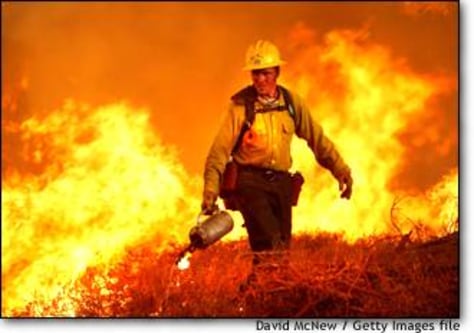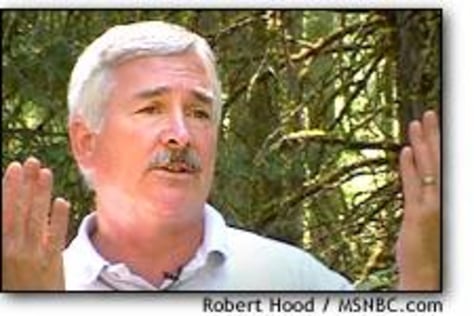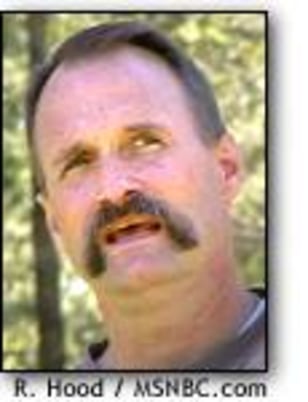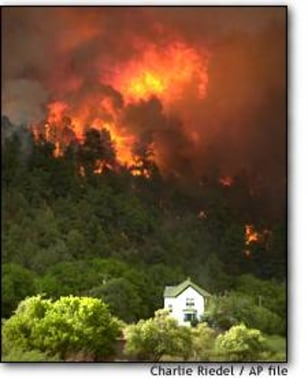
- Font:
- +
- -
Aug. 20, 2002 — Call it the “Bambi” effect: Wildfires have become visual dramas for most Americans, who watch on television every summer as marching walls of flame give way to huge swaths of dead, charred landscape. But damage to the land goes far beyond the stark images.
It's more proof that real life is nothing like Disney. In the aftermath of devastating wildfires, fire-prone trees sprout on old-growth land, native animal species dwindle and local watersheds are slowly depleted.
Nowhere have such changes occurred more profoundly than in the American West, where farming and grazing in the 19th century, rapid development during the 20th century and a long history of aggressively fighting wildfires have left an indelible mark on the land.
In the West, the major worry is about “condition class 3” forests — those that have suffered significant changes because naturally occurring fires have been suppressed for decades. Some 80 million such acres exist across the West, much of them mixed pine forests that might have faced low-intensity fires every 10 years had man not intervened.
“There’s wide agreement that the elimination of fire is a contributing factor for all this, not just that we stopped fires that naturally had started but that we stopped lighting fires,” says fire historian Stephen Pyne.
When fire was good
Wildfire wasn’t always considered a danger. Blazes became anathema only when Western wild lands were appropriated for cattle grazing, timber harvesting and finally 20th century development.

Those forests relied on frequent, low-intensity burns to remain healthy. Lit by lightning strikes, dry heat and native tribes, blazes would skirt along the ground, burning off underbrush and debris, revitalizing the soil and weeding out sickly trees.
“It kept these forests sort of open and park-like,” says University of Washington fire ecologist Jim Agee. “You could have galloped a horse through without ever hitting a branch.”
When fire became bad
When forest officials began suppressing fires, hundreds of young, smaller trees filled the nation’s forests, crowding out larger, 300-year-old trees that could withstand flames.

“The dining room table’s been set for beetles and root disease,” says Paul Hessburg of the U.S. Forest Service, who studies forest pathology for the Fire and Fire Substitute Study.
Perhaps worst of all, the dense underbrush in forests became fuel for severe fires that burned everything in their path.
If suppressing fire prompted biological upheaval, healing will also require broad ecological change, including the return of fire.
Bringing fire back
Setting the land ablaze — even in the carefully monitored situations endorsed by many land managers — remains risky. The dense underbrush and dead biomass on forest floors are potent fuel; low-hanging limbs would shoot flames up into tree crowns, where fire can travel farthest and do the most damage. And wildlife that adapted to the modern forest could be displaced.
“Reintroducing fire is a lot like reintroducing a lost species. It’s going to depend on the habitat,” says Pyne, a professor at Arizona State University and former wildfire fighter. “It’s not some magical ecological pixie dust.”
Land managers hope to begin thinning forests by hand and machine. Some smaller trees would be removed to leave room for larger, heartier specimens. Low branches would be trimmed. Smaller plants and fire-prone grasses could be reintroduced — species such as bracken fern and snowberry, which keep fires on the ground.
As always, balance is key. There is no blanket solution for the nation’s millions of acres of forest and open land.
Beyond forest fires
Though forest fires capture our attention, wildfires also occur elsewhere but get scant attention. Great Plains grasslands burn fiercely each year, and Western shrub steppe — millions of acres of arid open land — has suffered from fire’s absence just as the forests have.

“You had a kind of a double whammy,” says David Dobkin, executive director of the High Desert Ecological Research Institute. “You had the introduction of large herds of grazing animals ... and you had the removal of fire, which was the dominant ecological process that controlled the distribution and abundance of plant and animal species on the landscape.”
Today, conservationists want federal protection for the steppe’s shrinking sage grouse population, but even that would barely turn back changes on the steppe.
Protecting the 'intermix'
Most future fire management work will be near populated areas, in the “intermix” between developed and wild land. Today, nearly 40 percent of all new Western development occurs in these interface areas.
Thinning all of America’s forests would be prohibitively expensive.
At best, land managers might win funding for occasional, small-scale thinning in the wild in an attempt to break the flow of fire from one area to the next. But limited funds, clashing scientific research and persistent political bickering make it unlikely that large-scale restoration will occur.
“For the next decade or so, at least, we’ll continue to be caught in this gridlock, and unless the weather changes and becomes very wet for a while, those areas will simply incinerate,” Pyne says.
Homeowners might be well-served by taking a broader view: Fire’s long-term effects can linger far from the burn site. Charred soil, leached of nutrients, often can’t absorb water and washes away in mudslides during summer floods. This summer’s Hayman fire in Colorado charred large swaths of Denver’s watershed, filling reservoirs with carbon and fire debris.
Steps to restoration
Rather than sweeping changes, ecologists eye baby steps toward restoration of the nation’s forests and grassland. They hope to replace invasive plant species by replanting original ones. When cheatgrass burns across the steppe, for example, it can be replaced by hardier native grasses and shrubs.
Forest density would be continuously improved with thinning and the gradual return of fire. Small amounts of biomass would be left on forest floors as habitats for native animals, and small plants such as ceanothus would be planted to rebalance and nourish soil.
There would be trade-offs. Some species — such as the flying squirrel or the flammulated owl — might lose habitat while others thrive.
“There are many proponents of wilderness who I think are interested in the wild of nature. And in some way, ‘natural’ doesn’t enter into it,” says Pyne. “We can’t figure out what ‘natural’ is, so it’s really ‘wild.’”
Staking out a middle ground
Ultimately, the resulting landscape would be a hybrid between the ancient and the modern.
This middle ground shows promise: An extensive management plan for the forests of California’s Sierra Nevada Range took 10 years to craft, but it sets rules for how and where thinning can occur. Now facing additional review by the Bush administration, the plan took shape through long negotiation among land managers, environmental groups and the timber industry.
“Something has got to give here because it does seem like it has been taken to stalemate,” says Jay Watson, who represented the Wilderness Society in crafting the Sierra plan. “Everyone is going to have to make a good-faith effort at finding a solution and making it work.”
© 2013 msnbc.com Reprints






“ ”